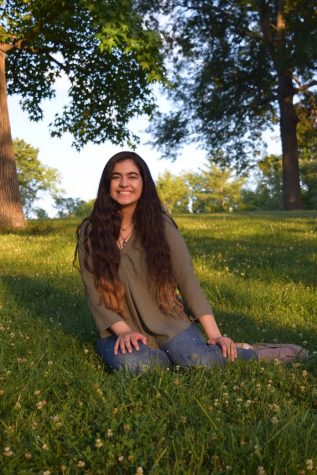Throughout the hallways, classroom doors are uniquely decorated with tokens of African-American history. Starting early mornings, students listened to their classmates’ recitation of African-American poetry over the announcements.
Although these traditions are new, Black History Month has been celebrated annually with events like the African-American Read-In. This year, the African-American Student Acceleration Program (ASAP) members wore red March 1, the day of the read-in, and encouraged others to as well.
“It’s a color of strength and unity,” ASAP President and senior Kyra Clerk said. “It represents togetherness; it will unite us as a community. I would love to see our counterparts [people of races other than African-American] do it as well. It would show that we’re all supporting each other and that we’re all together in this.”
ASAP is a club for academically accelerated African American students. The group focuses on social issues by bringing guest speakers to engage with the students. Clerk explains how the group has celebrated this month.
“It’s a really good month, and it meant a lot to most of us–all of us–actually. We all talked about it in ASAP,” Clerk said. “We had to write these cards talking about why we’re happy that we’re African-American.”
This being her first year attending the African-American Read-In, Clerk was grateful to be selected to lead the event.
“I felt like [the read-in] gave us a chance to express the beliefs of our culture and our experiences, and it strengthened us,” Clerk said. “Reading what Maya Angelou or Tupac said just empowered us.”
Within the district, there are a few annual events that highlight Black History Month as well, such as the Spirit of Excellence Ceremony.
“It’s meant for all African American students who have a 3.5 GPA or higher. Since I fall into that category, I was selected to go, and my parents wanted to go to the ceremony as well,” junior Ridwan Oyebamiji said. “They thought it would be a good experience for us to go.”
Oyebamiji planned to attend this ceremony, which recognizes and appreciates the district’s diverse community during Black History Month, for his second year.
“Just highlighting achievement for a minority group that’s not represented as much is important. Academic achievement sadly doesn’t come as often to our group,” Oyebamiji said. “To display the African American students who are actually doing well academically may encourage other African American students to achieve better marks or get more involved in extracurriculars.”
Along with Spirit of Excellence, the Superintendent’s Social Justice Leadership Advisory Council (SSJLAC) held a field trip Feb. 19, which centered around racial issues.
“It was eye-opening because it made us realize why we learn the things we do and how certain things affect people of color,” sophomore and SSJLAC member Tiyé Hyler said. “The kids that live in the county don’t see the problems that go on in the city. Even they say that it’s kind of like a bubble around them, so they don’t really get into the things that really go on. [For example], we have to wake up an hour early to get on the bus and drive all the way out here, which is like a 40-minute drive. They only have to drive like 15 to 20 minutes because they live close to the school.”
While many of these discussions happened through clubs and activities, Hyler appreciated the poetry recited on the announcements.
“It was nice for the poetry to be over the intercom for the whole school [to] hear because I knew people were listening. One of the poems was about how we, black people, feel in the climate now in our school and basically told everyone to wake up. People listen to the announcements; even the teachers stop to hear what’s going on. I feel like [our administrators] kind of puts it on the spot like this is important, you have to listen to it. They made it a priority,” Hyler said. “I just feel like some of the stuff that us black people try to do is pushed to the side [at school]. It’s like, you can do it, but you have to make sure these people are comfortable and you have to do it this way. But when they did it on the announcements, everybody had to hear it, no matter what.”
While Hyler appreciates the discussion at SSJLAC and the poetry on the announcements, she does not feel that the school adequately celebrates Black History Month.
“Honestly, I feel like we need to take it more seriously and make it more known,” Hyler said. “We have posters here, we have a wall, but I feel like we should have an assembly or something that’s more visible for people to see because, chances are, people don’t really look at the walls.”
Clerk would like to see Black History Month addressed in the classroom as well.
“We [could] form a question and do a restorative circle; I think during Common Ground would be a good time. It’s a circle in which you become very vulnerable and you talk about topics that should be talked about more, and you open up about it,” Clerk said. “Questions like: ‘Have you ever felt uncomfortable in the classroom because of your skin color? Have you ever felt like you’ve been treated differently because of your skin color outside the classroom? Has a student of color ever felt comfortable talking to you about a problem?’”
Despite the celebrations she participated in, Clerk feels that, if classroom teachers talked more about African American achievements, it would impact the way students learn from Black History Month.
“It would just be better for people to understand that oh, we weren’t just slaves, we were actually helping people create things. There were abolitionists as well, but we were also a part of making the US what it is today,” Clerk said.


![Listening to her peers at the African American Read-In, senior Kyra Clerk wears red in support of the event. Clerk worked to spread the word verbally about the event. “The only time we really hear about [African American] stuff is in history class, and mainly it's about slavery. We hardly ever hear about accomplishments of African Americans and what we’ve done for the country,” Clerk said.](https://pwestpathfinder.com/wp-content/uploads/2019/03/DSC_0016-900x600.jpg)
![Gazing up from the stage, junior Joseph McCurdy who played Peter Pan in the school play, Lost Girl, sits next to senior Juliana Rogers, who plays Wendy Darling, during a theater rehearsal. McCurdy’s passion for theater began when he observed a West High production in middle school. “I've been in the high school theater program since I was a freshman. I've always loved theater, but [what prompted me to join] was [when] I went to see [a performance here] when I was in middle school, and it was super cool,” McCurdy said.](https://pwestpathfinder.com/wp-content/uploads/2025/11/IMG_6535-1200x798.jpeg)

![Standing tall, stacked in a precise formation, the cheer team strikes a signature pose during halftime on Sept. 12 at the varsity football game. Nearly a month after this performance, the cheer team performed at the Missouri Cheerleading Coaches Association (MCCA) regional competition on Oct. 4, 2025. “We've all come [to] work together a lot more,” sophomore Elyssa Philippi said. “We're a lot closer than we were [earlier in the season] and going to state has made us closer [in] trying to work with each other, learn [new] skills and make our team better.”](https://pwestpathfinder.com/wp-content/uploads/2025/11/DSC5139-1.jpg)
![Handing out candy to excited trunk-or-treaters, President of the United Nations Children’s Fund club and junior Sara Ashok represents that group. Ashok was eager to participate in this event for multiple reasons. “I really wanted to be a part of the event because I get to help create memories for kids and spend time with my friends, spreading the things [I'm passionate about],” Ashok said.](https://pwestpathfinder.com/wp-content/uploads/2025/11/DSC_8648-1-1200x800.jpg)

![Smiling in a sea of Longhorns, Fox 2 reporter Ty Hawkins joins junior Darren Young during the morning Oct. 3 pep rally. The last time West was featured in this segment was 2011. “[I hope people see this and think] if you come to [Parkway] West, you will have the time of your life because there are so many fun activities to do that make it feel like you belong here. I was surprised so many people attended, but it was a lot of fun,” Young said.](https://pwestpathfinder.com/wp-content/uploads/2025/10/Edited2-1200x798.jpg)
![West High seniors and families listen as a representative of The Scholarship Foundation of St. Louis, Teresa Steinkamp, leads a Free Application for Federal Student Aid (FAFSA) workshop. This session, held in the library, provided guidance on financial aid, scholarships and student loan options. “This event is very beneficial for any seniors who are applying to or considering applying to colleges after high school [because] the cost of college is on the rise for seniors and parents,” college and career counselor Chris Lorenz said.](https://pwestpathfinder.com/wp-content/uploads/2025/09/DSC_4478-1200x778.jpg)
![Senior Kamori Berry walks across the field during halftime at the Homecoming football game on Sept. 12. During the pep assembly earlier that day, she was pronounced Homecoming Queen. “I thought it was nice that the crowd [started] cheering right away. I know [my friends] were really excited for me, and my family was happy because typically non-white people don't win,” Berry said.](https://pwestpathfinder.com/wp-content/uploads/2025/09/DSC7046-Enhanced-NR-1200x798.jpg)



Zainab Oyebamiji • Apr 1, 2019 at 5:51 pm
Very well written. Stay high, remain top